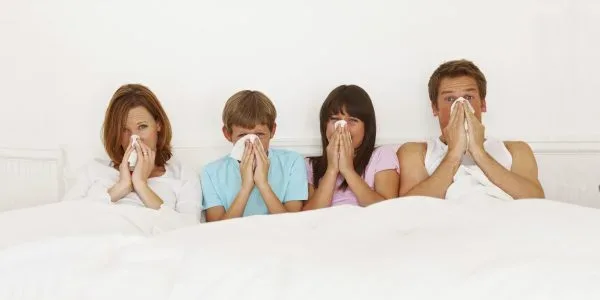Influenza, or “the flu,” and the common cold are upper respiratory viruses which usually peak in the winter. Many people think the flu is just a really bad cold, but this is incorrect. They have some similarities, but the flu is more than just a severe cold. Typically, the flu is either type A or B, but there are also subtypes, such as the “swine flu,” known as H1N1. There are hundreds of common cold viruses, including enterovirus and rhinovirus. Both flu and cold viruses are highly contagious from person-to-person contact, especially from respiratory droplets when coughing or sneezing. Both viruses can live on contact surfaces such as doorknobs, tables and countertops, shopping carts, keyboards and computer mice.
Common cold signs and symptoms include:
- Nasal congestion.
- Runny nose.
- Cough.
- Sore throat.
- Fatigue.
- Headache.
- Sneezing.
With a cold virus, a high fever and body aches are less common. There is no vaccination for cold viruses, but there is a yearly flu vaccine designed to protect against the flu as it mutates over time.
The signs and symptoms of influenza include:
- High fevers.
- Body aches and chills.
- Fatigue and weakness.
- Sore throat.
- Runny nose.
- Dizziness.
- Nausea and vomiting.
- Loss of appetite.
Flu complications are much more common than they are for a cold. Cold viruses usually clear up on their own with over-the-counter cold and cough meds, but flu can lead to pneumonia and other complications from the stress the virus causes on the body. Usually the very young, the elderly and immunocompromised patients (such as those with HIV/AIDS) have higher risk of flu complications. Physicians can prescribe antivirals for influenza if the patient meets certain criteria.
Cold and flu prevention is very similar. Good hand-washing is key for both. Annual influenza vaccinations, or “flu shots,” also help prevent the spread of the flu. Staying home when sick, or coughing and sneezing into a bent arm instead of your hands, decreases the number of people exposed. Wiping down surfaces with bleach wipes can kill both viruses. It is also recommended not to visit sick patients in a hospital if having signs or symptoms of a cold or flu virus. Other infection barriers include wearing a mask when around other people, and replacing a handshake with a non-contact gesture such as a wave.
Patient can now schedule online appointments for sick visits through Northern Arizona Healthcare’s patient portal, MyNAHealthcare. If you’re sick and need to be seen within 24-48 hours, you can schedule an appointment through the patient portal at one of our five primary care clinics. This applies to adult sick visits only.
